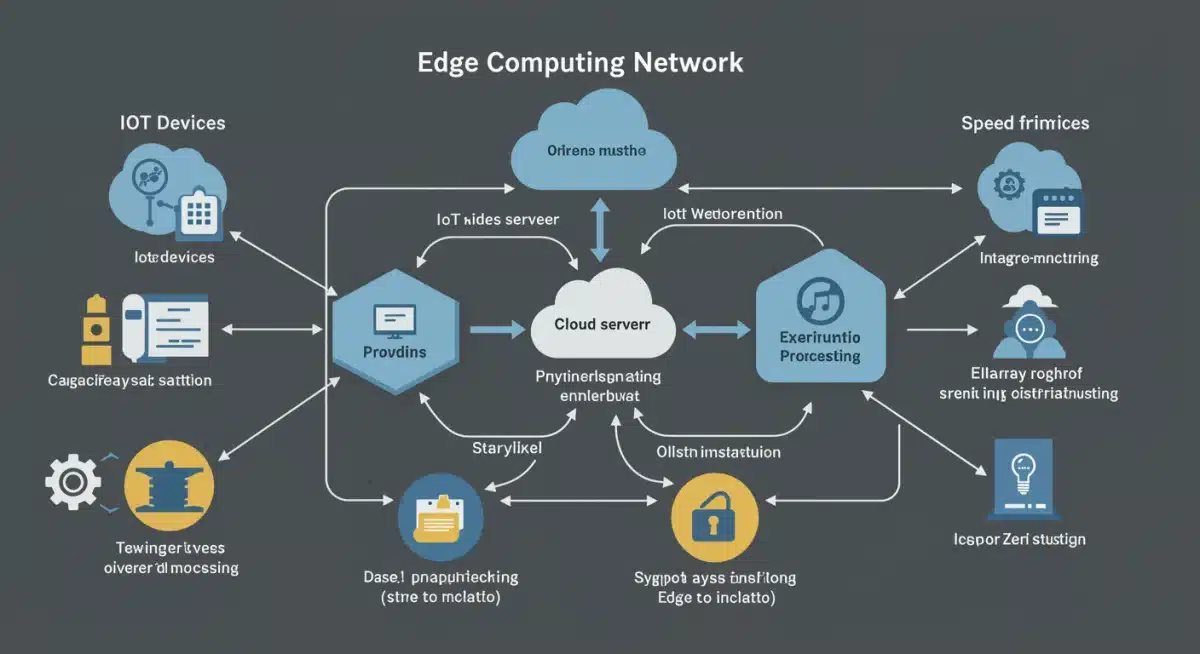Projected 2025 Growth of Edge Computing for Enhanced Global Connectivity in the US (FINANCIAL IMPACT)

The projected 2025 growth of edge computing in the US is set to dramatically enhance global connectivity and reshape financial landscapes, driven by increased demand for real-time data processing and localized intelligence.
Breaking news reveals that the Projected 2025 Growth of Edge Computing for Enhanced Global Connectivity in the US (FINANCIAL IMPACT) is accelerating, poised to redefine how data is processed and utilized across industries. This technological shift promises significant financial implications and a new era of connectivity.
Understanding Edge Computing’s Rapid Expansion
Edge computing, a distributed computing paradigm, brings computation and data storage closer to the data sources, reducing latency and bandwidth usage. This proximity is becoming crucial for applications demanding real-time processing, such as autonomous vehicles, smart factories, and augmented reality. The United States is currently at the forefront of this rapid expansion, driving innovation and deployment across various sectors.
As of late 2024, industry reports indicate a significant acceleration in edge infrastructure development. Major technology firms and telecommunications providers are investing heavily, recognizing the strategic advantage of localized processing. This move is not merely an incremental upgrade but a foundational shift in how digital services are delivered and consumed, impacting everything from consumer devices to critical national infrastructure.
Key Drivers of Edge Adoption
- Low Latency Requirements: Applications like autonomous systems and real-time analytics require immediate data processing.
- Bandwidth Optimization: Reducing the amount of data sent to central clouds alleviates network congestion.
- Enhanced Security: Processing sensitive data locally can reduce exposure to cyber threats during transit.
- Scalability and Resilience: Distributed architecture offers greater flexibility and reduces single points of failure.
Financial Impact: Billions in New Revenue and Investment
The financial ramifications of the Projected 2025 Growth of Edge Computing for Enhanced Global Connectivity in the US (FINANCIAL IMPACT) are staggering, with analysts forecasting a multi-billion dollar market. This growth is fueled by both direct investments in edge infrastructure and the indirect economic benefits derived from improved operational efficiencies and new service offerings. Companies are recognizing that early adoption of edge computing translates into a competitive edge and significant returns.
According to recent projections by leading market research firms, the US edge computing market alone is expected to surpass tens of billions of dollars by 2025. This includes spending on hardware, software, and services. Furthermore, venture capital funding for edge-focused startups has seen a substantial uptick, highlighting investor confidence in the technology’s long-term potential. This influx of capital is accelerating innovation and deployment, creating a robust ecosystem for edge computing solutions.
Investment Hotbeds and Sector Growth
- Telecommunications: 5G rollouts are intrinsically linked with edge computing, driving massive infrastructure investments.
- Manufacturing: Smart factories leveraging edge for predictive maintenance and quality control are seeing significant ROI.
- Healthcare: Real-time patient monitoring and data analysis at the edge are enhancing care delivery and reducing costs.
- Retail: Personalized customer experiences and inventory management are being revolutionized by localized processing.
Edge Computing’s Role in Global Connectivity Enhancement
The enhancement of global connectivity through edge computing is a critical component of the Projected 2025 Growth of Edge Computing for Enhanced Global Connectivity in the US (FINANCIAL IMPACT). By decentralizing data processing, edge computing alleviates pressure on central data centers and long-haul networks, leading to faster, more reliable connections worldwide. This is particularly vital for regions with limited internet infrastructure or where data sovereignty is a significant concern.
The deployment of edge nodes in strategic locations, often closer to end-users or IoT devices, means that data no longer needs to travel vast distances to a centralized cloud for processing. This localized approach drastically reduces latency, which is paramount for interactive applications and critical infrastructure. As more devices become connected globally, the ability of edge computing to manage and process this flood of data locally will be indispensable for maintaining efficient and resilient global networks.
Technological Advancements Driving 2025 Projections
Several key technological advancements are underpinning the robust Projected 2025 Growth of Edge Computing for Enhanced Global Connectivity in the US (FINANCIAL IMPACT). Innovations in hardware, software, and networking protocols are making edge deployments more efficient, scalable, and secure. These advancements are not isolated but rather interconnected, creating a synergistic effect that propels the entire edge ecosystem forward.

One significant area of progress is the development of more powerful yet compact edge devices, capable of handling complex AI and machine learning workloads on-site. Coupled with this, advancements in containerization and orchestration technologies, such as Kubernetes, are simplifying the management and deployment of applications across distributed edge environments. These software tools enable organizations to deploy and scale edge applications with unprecedented ease and flexibility, reducing operational complexities and costs.
Innovations Fueling Edge Expansion
- AI/ML at the Edge: Embedded AI processors enable real-time inference without cloud dependency.
- 5G Integration: Ultra-low latency and high bandwidth of 5G networks are perfect complements for edge computing.
- Security Enhancements: New cryptographic techniques and secure hardware modules are bolstering edge security.
- Energy Efficiency: Development of low-power edge devices reduces operational costs and environmental impact.
Challenges and Opportunities in Edge Deployment
While the Projected 2025 Growth of Edge Computing for Enhanced Global Connectivity in the US (FINANCIAL IMPACT) presents immense opportunities, it also comes with a unique set of challenges. Organizations deploying edge solutions must navigate complexities related to security, data management, and integration with existing IT infrastructure. Addressing these challenges effectively will be crucial for realizing the full potential of edge computing and ensuring widespread adoption.
One primary challenge revolves around the distributed nature of edge deployments, which can complicate security management and data governance. Ensuring consistent security policies and compliance across numerous edge locations requires robust management tools and protocols. Moreover, integrating edge environments with existing cloud and on-premise systems demands careful planning and interoperability solutions. However, these challenges also create opportunities for new service providers specializing in edge security, management, and integration, further stimulating economic growth.
Overcoming Deployment Hurdles
- Standardization: Developing common standards for edge hardware and software fosters interoperability.
- Skilled Workforce: Training and recruiting professionals with expertise in edge technologies is paramount.
- Regulatory Frameworks: Establishing clear guidelines for data privacy and security at the edge.
- Cost Management: Optimizing deployment costs for hardware, software, and ongoing maintenance.
Policy and Regulatory Landscape for Edge in the US
The policy and regulatory landscape plays a pivotal role in shaping the Projected 2025 Growth of Edge Computing for Enhanced Global Connectivity in the US (FINANCIAL IMPACT). Government initiatives, data privacy regulations, and infrastructure policies significantly influence the pace and direction of edge computing adoption. A supportive regulatory environment can accelerate deployment, while restrictive policies could hinder progress.
Currently, there is a growing recognition among US policymakers regarding the strategic importance of edge computing for national competitiveness and critical infrastructure resilience. This awareness is translating into initiatives aimed at fostering innovation, securing edge environments, and promoting workforce development. Data privacy regulations, such as those concerning personal identifiable information, are also being adapted to address the unique challenges posed by distributed data processing at the edge, ensuring consumer trust and compliance.
Key Policy Considerations
- Data Sovereignty: Regulations concerning where data is processed and stored.
- Cybersecurity Standards: Developing robust security frameworks for edge devices and networks.
- Infrastructure Funding: Government investments in broadband and 5G infrastructure to support edge deployments.
- Ethical AI Use: Guidelines for AI and machine learning applications running at the edge.
| Key Point | Brief Description |
|---|---|
| Market Size Projection | US edge computing market expected to reach multi-billions by 2025, driven by diverse sector investments. |
| Global Connectivity Impact | Decentralized processing reduces latency and bandwidth, enhancing global network efficiency and resilience. |
| Technological Drivers | AI/ML at the edge, 5G integration, and advanced security are accelerating adoption and innovation. |
| Challenges & Opportunities | Security, data management, and integration complexities create new market segments and demand for specialists. |
Frequently Asked Questions About Edge Computing Growth
The primary drivers include the escalating demand for real-time data processing, the proliferation of IoT devices, and the need for reduced latency in critical applications like autonomous systems. Additionally, advancements in 5G technology and AI capabilities at the edge are accelerating its adoption across various industries.
The financial impact is projected to be substantial, with the US edge computing market expected to reach tens of billions of dollars. This growth stems from direct investments in infrastructure, software, and services, alongside indirect benefits from enhanced operational efficiencies and the creation of new market opportunities and specialized roles.
Edge computing enhances global connectivity by decentralizing data processing, moving it closer to the source. This significantly reduces latency and bandwidth strain on central networks, leading to faster, more reliable, and efficient global data transmission. It’s crucial for supporting high-demand, interactive applications worldwide.
Key technological advancements include powerful, compact edge devices capable of AI/ML workloads, robust 5G integration for high-speed connectivity, and improved security protocols. Containerization and orchestration tools like Kubernetes also simplify managing distributed edge applications, making deployments more flexible and scalable.
Significant challenges include managing security across distributed environments, ensuring effective data governance, and integrating edge solutions with existing IT infrastructure. Addressing these requires standardization, a skilled workforce, and clear regulatory frameworks for data privacy and cybersecurity, creating new opportunities for specialized services.
What Happens Next
As the Projected 2025 Growth of Edge Computing for Enhanced Global Connectivity in the US (FINANCIAL IMPACT) continues its upward trajectory, industry observers and policymakers are closely monitoring its evolution. The coming months will likely see further consolidation among technology providers, increased strategic partnerships, and a heightened focus on developing standardized protocols for edge deployments. We anticipate more government initiatives aimed at securing edge infrastructure and fostering innovation, particularly in critical sectors. Businesses should prepare for a landscape where localized, real-time data processing becomes the norm, driving both operational efficiency and new revenue streams, fundamentally reshaping the digital economy.





